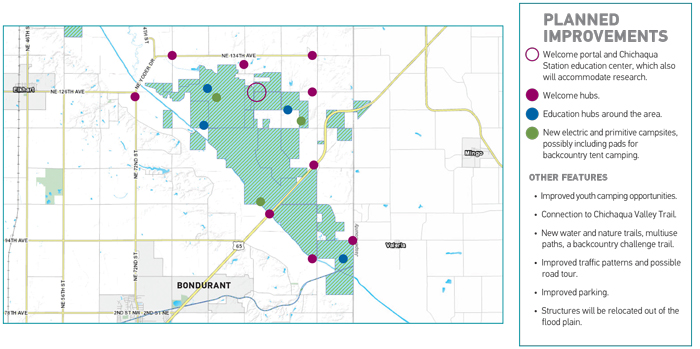Wild!: Polk County Conservation plans improvements at Chichaqua Bottoms Greenbelt

Chichaqua Bottoms Greenbelt — one of the largest natural attractions in Polk County, yet unknown to many — is about to get a five-year facelift that will make it easier to use.
The 9,100-acre prairie wetland near Elkhart is one of the biggest natural areas in Iowa. It is larger than both Des Moines Water Works Park (1,500 acres) and Neal Smith National Wildlife Refuge near Prairie City (5,600 acres).
It is home to rare species such as Blanding’s turtle and the ornate box turtle, as well as butterflies, bull snakes, bobcats, deer, birds and prairie plants. Its tall grasses regularly attract hunters looking for pheasants, deer and other game. Old oxbows lure paddlers, and ponds attract people who like to fish. The few who know about Chichaqua, anyway.
“Most people in Des Moines don’t know it exists,” said Richard Leopold, Polk County Conservation Board director.
The Polk County Conservation Board a few months ago approved a new master plan for Chichaqua, hoping both to improve access and to get the sprawling prairie on people’s fun radar.
Plans call for the county to use bonds to finance $500,000 to $1 million in Chichaqua improvements, which also may benefit from $2 million or so in state and federal grants.
Don’t expect a water park, a miniature golf course or a grand lodge. When the board asked RDG Planning & Design and HR Green Inc. to map out Chichaqua’s future, it was all about the natural environment, Leopold said.
This is a place where Drake University students discovered Blanding’s turtles, and it is also home to tiger salamanders. The rural landscape lends itself to stargazing.
“Conservation and preservation are number one,” Leopold said. “It is not a park. It’s about hunting and turtles and sandhill cranes. It’s probably one of the wildest places in Iowa.”
County naturalists admit that with the natural hydrology changed by drainage ditches in the area, roads and other factors, this is far from virgin prairie. Still, Leopold said, in a state that is considered the most altered landscape in the country, Chichaqua is one of the wildest places around. The county can join its partners to make it as wild as possible, or let it degrade.
“We can spend decades managing the system, or we let nature’s whims go,” Leopold said. Without managment, species would be lost, and invasive plants and animals could disrupt what’s left of the prairie feel, he added.
Wildness is going to win, Leopold said. The county will make it easier to visit Chichaqua, but the projects will be chosen carefully to preserve nature.
“Sandhill cranes are nesting out there,” Leopold said. “I want people to see that, but I don’t want to run a four-lane highway in there. “
So the work will be a mixture of gentle construction of paths, a small visitors’ center and research facility, campsites and possibly lookout towers.
Ecologist Keith Summerville of Drake University has been working on a plan to make sure whatever minimal development occurs at Chichaqua doesn’t disrupt critical habitat for plants and animals.
“People can literally get a taste of what Iowa used to be like,” he said.
Why is that important?
“I think people are increasingly aware of the disconnect from the natural landscape,” Summerville said. “If you want to see what native Polk County looked like, this and Neal Smith are your best bets.”
“If you look at what (famed biologist) E.O. Wilson has written … there is an unconscious psychological connection between us as a being and the natural world as our home,” he said. “An artificial landscape can’t sustain the innate spirit of an individual in the same way.”
“This place is an endless tapestry of color when the prairie is in bloom,” Summerville said.
Leopold said new signs, better trails and parking, bike trail connections and a possible auto route will give the county a better chance of luring visitors to one of the county’s largely undiscovered natural areas. He added: “Within two years, there will be a welcome mat out on the land out there.”










